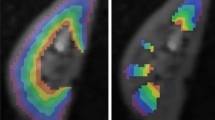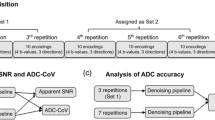Abstract
The aim of this study is to develop a novel phantom for the evaluation of clinical CEST imaging settings, e.g., B0 and B1 field inhomogeneities, CEST contrast, and post-processing. We made a phantom composed of two slice sections: a grid section for local offset frequency evaluation and a sample section for CEST effect evaluation using different concentrations of an egg white albumin solution. On a 3 Tesla MR scanner, a phantom study was performed using CEST imaging; the mean B1 amplitudes were set at 1.2 and 1.9 µT, and CEST images with and without B0 corrections were acquired. Next, region of interest (ROI) analysis was performed for each slice. Then, CEST images with and without B0 corrections were compared at each B1 amplitude. The B0 corrected Z-spectrums at each local region in the grid section showed a shifting of the curve bottom to 0 ppm. Z-spectrum at B1 = 1.9 µT showed a broader curve shape than that at 1.2 µT. Moreover, MTRasym values at 3.5 ppm for each albumin sample at B1 = 1.9 µT were about two times higher than those at 1.2 µT. Our phantom enabled us to evaluate and optimize B0 inhomogeneity and the CEST effect at the B1 amplitude.







Similar content being viewed by others
References
Ward KM, Aletras AH, Balaban RS. A new class of contrast agents for MRI based on proton chemical exchange dependent saturation transfer (CEST). J Magn Reson. 2000;143(1):79–87. https://doi.org/10.1006/jmre.1999.1956.
Zhou J, Payen JF, Wilson DA, Traystman RJ, van Zijl PC. Using the amide proton signals of intracellular proteins and peptides to detect pH effects in MRI. Nat Med. 2003;9(8):1085–90. https://doi.org/10.1038/nm907.
Park JE, Kim HS, Park KJ, Kim SJ, Kim JH, Smith SA. Pre- and posttreatment Glioma: comparison of amide proton transfer imaging with MR spectroscopy for biomarkers of tumor proliferation. Radiology. 2016;278(2):514–23. https://doi.org/10.1148/radiol.2015142979.
Dean BL, Drayer BP, Bird CR, Flom RA, Hodak JA, Coons SW, et al. Gliomas: classification with MR imaging. Radiology. 1990;174(2):411–5. https://doi.org/10.1148/radiology.174.2.2153310.
Togao O, Yoshiura T, Keupp J, Hiwatashi A, Yamashita K, Kikuchi K, et al. Amide proton transfer imaging of adult diffuse gliomas: correlation with histopathological grades. Neuro Oncol. 2014;16(3):441–8. https://doi.org/10.1093/neuonc/not158.
Mehrabian H, Desmond KL, Soliman H, Sahgal A, Stanisz GJ. Differentiation between radiation necrosis and tumor progression using chemical exchange saturation transfer. Clin Cancer Res. 2017;23(14):3667–75. https://doi.org/10.1158/1078-0432.CCR-16-2265.
Sun PZ, Zhou J, Sun W, Huang J, van Zijl PC. Detection of the ischemic penumbra using pH-weighted MRI. J Cereb Blood Flow Metab. 2007;27(6):1129–36. https://doi.org/10.1038/sj.jcbfm.9600424.
Kanazawa Y, Fushimi Y, Sakashita N, Okada T, Arakawa Y, Miyazaki M. B1 power optimization for chemical exchange saturation transfer imaging: a phantom study using egg white for amide proton transfer imaging applications in the human brain. Magn Reson Med Sci. 2018;17(1):86–94. https://doi.org/10.2463/mrms.tn.2016-0069.
Sun PZ, Wang E, Cheung JS, Zhang X, Benner T, Sorensen AG. Simulation and optimization of pulsed radio frequency irradiation scheme for chemical exchange saturation transfer (CEST) MRI-demonstration of pH-weighted pulsed-amide proton CEST MRI in an animal model of acute cerebral ischemia. Magn Reson Med. 2011;66(4):1042–8. https://doi.org/10.1002/mrm.22894.
Sun PZ, Benner T, Kumar A, Sorensen AG. Investigation of optimizing and translating pH-sensitive pulsed-chemical exchange saturation transfer (CEST) imaging to a 3T clinical scanner. Magn Reson Med. 2008;60(4):834–41. https://doi.org/10.1002/mrm.21714.
Kim M, Gillen J, Landman BA, Zhou J, van Zijl PC. Water saturation shift referencing (WASSR) for chemical exchange saturation transfer (CEST) experiments. Magn Reson Med. 2009;61(6):1441–50. https://doi.org/10.1002/mrm.21873.
Stancanello J, Terreno E, Castelli DD, Cabella C, Uggeri F, Aime S. Development and validation of a smoothing-splines-based correction method for improving the analysis of CEST-MR images. Contrast Media Mol Imaging. 2008;3(4):136–49. https://doi.org/10.1002/cmmi.240.
Zhou J, Blakeley JO, Hua J, Kim M, Laterra J, Pomper MG, et al. Practical data acquisition method for human brain tumor amide proton transfer (APT) imaging. Magn Reson Med. 2008;60(4):842–9. https://doi.org/10.1002/mrm.21712.
Zaiss M, Ehses P, Scheffler K. Snapshot-CEST: optimizing spiral-centric-reordered gradient echo acquisition for fast and robust 3D CEST MRI at 9.4 T. NMR Biomed. 2018;31(4): e3879. https://doi.org/10.1002/nbm.3879.
Dixon WT, Hancu I, Ratnakar SJ, Sherry AD, Lenkinski RE, Alsop DC. A multislice gradient echo pulse sequence for CEST imaging. Magn Reson Med. 2010;63(1):253–6. https://doi.org/10.1002/mrm.22193.
Sun PZ, Farrar CT, Sorensen AG. Correction for artifacts induced by B(0) and B(1) field inhomogeneities in pH-sensitive chemical exchange saturation transfer (CEST) imaging. Magn Reson Med. 2007;58(6):1207–15. https://doi.org/10.1002/mrm.21398.
van Zijl PC, Yadav NN. Chemical exchange saturation transfer (CEST): what is in a name and what isn’t? Magn Reson Med. 2011;65(4):927–48. https://doi.org/10.1002/mrm.22761.
van Zijl PCM, Lam WW, Xu J, Knutsson L, Stanisz GJ. Magnetization transfer contrast and chemical exchange saturation transfer MRI. Features and analysis of the field-dependent saturation spectrum. Neuroimage. 2018;168:222–41. https://doi.org/10.1016/j.neuroimage.2017.04.045.
Scheidegger R, Wong ET, Alsop DC. Contributors to contrast between glioma and brain tissue in chemical exchange saturation transfer sensitive imaging at 3 Tesla. Neuroimage. 2014;99:256–68. https://doi.org/10.1016/j.neuroimage.2014.05.036.
Zhou J, Yan K, Zhu H. A simple model for understanding the origin of the amide proton transfer MRI signal in tissue. Appl Magn Reson. 2012;42(3):393–402. https://doi.org/10.1007/s00723-011-0306-5.
Schmitt B, Zaiss M, Zhou J, Bachert P. Optimization of pulse train presaturation for CEST imaging in clinical scanners. Magn Reson Med. 2011;65(6):1620–9. https://doi.org/10.1002/mrm.22750.
Lee DH, Heo HY, Zhang K, Zhang Y, Jiang S, Zhao X, et al. Quantitative assessment of the effects of water proton concentration and water T1 changes on amide proton transfer (APT) and nuclear overhauser enhancement (NOE) MRI: the origin of the APT imaging signal in brain tumor. Magn Reson Med. 2017;77(2):855–63. https://doi.org/10.1002/mrm.26131.
Acknowledgements
We thank Stan Himes for the English grammar correction and revision.
Funding
This study was partly supported by JSPS KAKENHI [grant number 17K09065].
Author information
Authors and Affiliations
Contributions
Conceptualization: YK; Methodology: YK; Formal analysis and investigation: DC, YK; Writing—original draft preparation: DC, YK; Writing—review and editing: YK, HH; Funding acquisition: YK, TM; Resources: MM; Supervision: MH, AH.
Corresponding author
Ethics declarations
Conflict of interest
MM is an employee of GE HealthCare; the other authors declare that they have no conflicts of interest.
Ethical approval
Approval was obtained from the ethics committee of Tokushima University Hospital. The procedures used in this study adhere to the tenets of the Declaration of Helsinki.
Consent to participate and publish
Written informed consent in this study was obtained from the subject. The subject signed informed consent regarding publishing their data and photographs.
Additional information
Publisher's Note
Springer Nature remains neutral with regard to jurisdictional claims in published maps and institutional affiliations.
About this article
Cite this article
Chiba, D., Kanazawa, Y., Miyati, T. et al. Simplified assessment for chemical exchanged saturation transfer (CEST) imaging: local offset frequency and CEST effect. Radiol Phys Technol 17, 93–102 (2024). https://doi.org/10.1007/s12194-023-00752-z
Received:
Revised:
Accepted:
Published:
Issue Date:
DOI: https://doi.org/10.1007/s12194-023-00752-z




